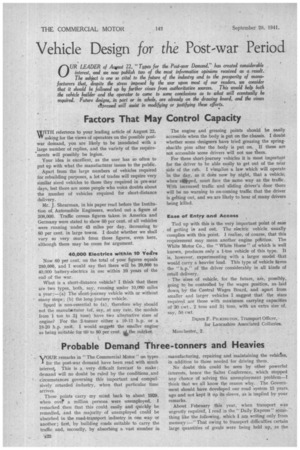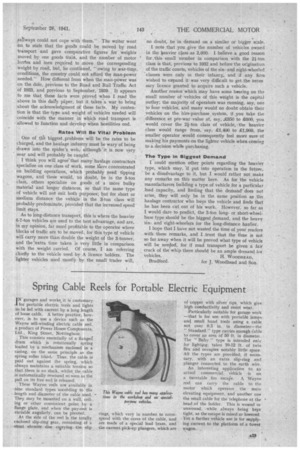Probable Demand Three-tanners and Heavies
Page 24

Page 25

If you've noticed an error in this article please click here to report it so we can fix it.
VOUR remarks in "The Commercial Motor" on types -t for the post-war demand have been read with much Interest,. This is a very difficult forecast to make ; demand will no doubt be ruled by the conditions_and circumstances governing this important and compulsively retarded industry, when that particular time arrives.
These points carry my mind back to about 1929, when ove? a million persons were unemployed. I remarked then that this could easily and quickly be remedied., and the majority of unemployed could be absorbed in the road-transport industry in one way or another ; first, by building roads suitable to carry the traffic and, secondly, by absorbing a vast number in _manufacturing, repairing and maintaining the vehicles, in addition to those needed for driving them.
No doubt this could be seen by other powerful -interests, hence the Salter Conference, which stopped any chance of solving this unemployment problem—I think that we all know the reason why. The Govern-ment should have developed our road system 15 years ago and not kept it up its sleeve, as is implied by your remarks.
About .February this year, when transport was urgently required, I read in the Daily Express" something like the following, which I am writing only from memory :—" That owing to transport difficulties certain large quantities of goods were being held up, as the
r. 4ways could not cope with them." The writer went on to state that the goods could be moved by road transport and gave comparative figures for weights moved by one goods train, and the number of motor lorries and Men required to move the corresponding -weight by road, but, he continued, " owing to war-time conditions, the country could not afford the man-power needed." How. different from when the man-power was on the dole, previous to the Road and Rail Traffic Act of 1933, and previous to September, 1939.. It appears to me that these facts were proved when I read the above in this daify paper, but it takes. a war to bring about the acknowledgment of these facts. My contention is that the type and weight of vehicles needed will coincide with the manner in which road transport is allowed to function and develop when hostilities end.
Rates Will Be Vital Problem One of the biggest, problems will be the rates to be charged, and the haulage industry must be wary of being drawn into the spider's web,. although it is now very near and will probably be caught. . I think you will agree' that many haulage contractors specialize on one class of work, some have concentrated on building operations, which probably need tipping wagons, and these would, no doubt, be in the 3-ton class, others specialize on goods of a more bulky material and longer distances, so that the same type of vehicle will not suit both purposes; but for short or medium distance the vehicle in the 3-ton class will probably predominate, provided that the increased speed limit stays.
As to long-distance transport, this is where the heavier 6-7-ton vehicles are used to the best advantage, and are, in my opinion, far more profitable to the operator where blocks of traffic are to be moved, for this type of vehicle will carry more than. double the weight of the 3-tonner, and the extra time taken is very little in comparison with the weight carried. Of course, I am referring chiefly to the vehicle used by A licence holders. The lighter vehicles used naostlY by the small trader will,
no doubt, be in demand on a similar or bigger -scale. I note that you give the number of vehicles owned in the laeavier class as 2,000. I believe a good reason for :this small number in comparison with the 2i-ton class is that, previous to 1932 and beforelbe origination of the traffic courts, vehicles of the sixand eight-wheeled -classes were only in their infancy, and if any firns wished to expand it was very difficult to get the neces sary licence granted to acquire such a vehicle.
Another reason which may have some bearing on the small number of vehicles of this weight is the capital outlay; the majority of operators was running, say, one to four vebiclee, and many would no doubt obtain their .vehicles on the hire-purchase system, if you take the difference at pre-war value at, say, £350 to £600, you would cover the 2i-ton class of vehicle, • the heavier class would. range from, say, £1,400. to £1,900, the smaller. operator would consequently feel more sure of making his payments on the lighter vehicle when coming to a decision while purchasing.
The Type In Biggest Demand I could mention other points regarding the heavier type, which may, If put into operation in the future, be a disadvantage to it, but I would rather not make any remarks on this matter here. As for the vehicle manufacturers building a type of vehicle.for a particular load capacity, and finding that the demand' does not arise, they will only he in the same position as the haulage contractor who buys the vehicle and finds that he has been cut out of his work. However, so far as I would dare to predict, the 3-ton longor short-wheelbase type should be the biggest demand, and the heavy sixand eight-wheelers for the long-distance haulier.
I hope that I have not wasted the time of your readers with these remarks, and I ,trust that the time is not so far away when it will be proved what type of vehicle will be needed, for if road transport be given a fair crack of the whip there should be an ample demand for
vehicles. H. WOODHEAD,
Bradford. for J. Woodhead and Son.




















































